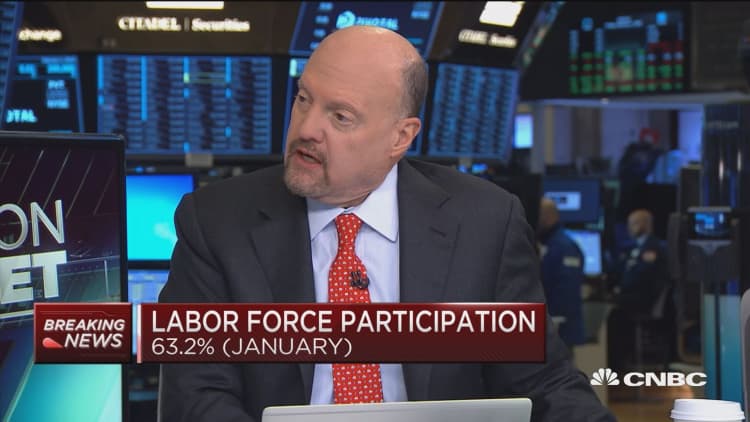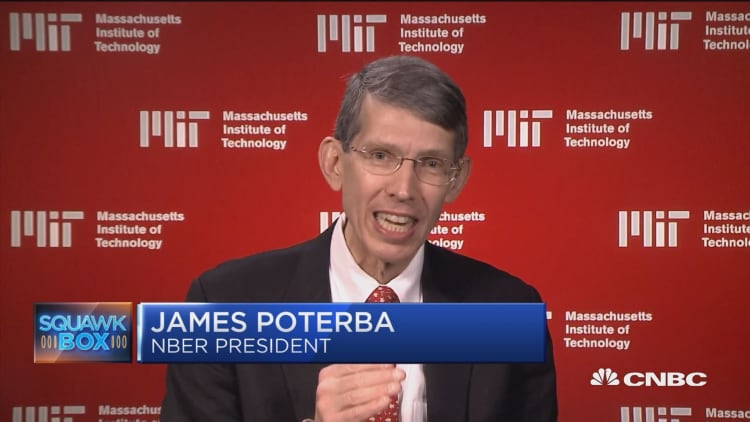January's super strong jobs report and a solid manufacturing survey on Friday showed that recession worries may be overblown and slowdown fears are not impacting corporate hiring or dampening manufacturers' sentiment.
The economy added a surprising 304,000 new jobs in January, well above the 165,000 expected by economists. Wages grew by an annual 3.2 percent, and were even higher for nonmanagerial workers with a 0.4 percent monthly gain.
"The labor market is still scorching," said Ward McCarthy, chief financial economist at Jefferies. "If you look at the payroll data, the economy continues to pound out job growth. Wage growth is for real."

ISM manufacturing was 56.6, well above the consensus of 54.2, but the important new orders component rose even more to 58.2 from 51 in December. A number above 50 reflects expansion, and while off recent highs, economists had expected the number to slow down even more. Consumer sentiment was also reported Friday and was significantly lower at 91.2, but it too beat expectations.
"I think really it's kind of the same story we took away from the [jobs report]. Even though the [Fed] committee was really dovish on Wednesday, things domestically are still pretty strong," said Ben Jeffery, rate strategist at BMO. "This is both producer and consumer sentiment readings at good levels. ... It definitely runs counter to what Powell said his concerns were on Wednesday."
The Federal Reserve on Wednesday strongly signaled that it was ready to pause in its interest rate-hiking cycle, and that its decision would depend on economic data and market conditions. The Fed also said it would review its balance sheet policy, suggesting it could end its program to shrink the balance sheet at some point. Investors have worried that the central bank could slow the economy with a tightening of conditions from both its rate policy and the balance sheet roll-down.
Now the fed funds futures market is pricing in a very slight chance of an interest rate cut this year even though the Fed still forecasts two hikes for later in the year, as do a number of economists. Prior to Wednesday, the futures were pricing a 20 percent chance of one rate rise in 2019.
'Perpetual pessimists'
"The perpetual pessimists have been calling for the next recession since the last one ended, and at some point they'll be right," said McCarthy. "If we don't get a trade deal, we could slow significantly but I don't think we're going into recession, and if we do get a trade deal we're going to be growing again."
McCarthy said the Fed's actions show that it is hedging against potential negatives, like the trade wars, China's slowdown, a government shutdown and a possible debt ceiling fight. Fed Chairman Jerome Powell affirmed a dovish stance when he briefed the media after the meeting.
The jobs report and ISM were even more important than usual because the partial government shutdown disrupted the releases of some important economic reports. The economy is expected to be slowing, but it's unclear how much. Fears of a recession weighed on the stock market in December, as investors worried about the Fed, China's slowing economy and trade wars.
"Powell can't catch a break today," wrote Societe Generale economist Omair Sharif.
"It seems that the hand-wringing over a sustained sharp slowdown in the factory sector may have been a bit premature. To be sure, it certainly looks like it has moderated from readings around 59-60...but a 55.5 average the last two months is still a healthy figure that signals continued expansion in manufacturing, " he added.

The unemployment rate ticked up to 4 percent from 3.9 percent, as more workers looked for jobs. December's payrolls were revised down to 222,000 from 312,000, but November was revised higher to 196,000 from 176,000.
"Who is calling for a recession this year again? Whoever it is, you can forget about it after a picture-perfect jobs report to start the year off right," wrote Chris Rupkey, chief financial economist at MUFG.
The government shutdown may have shown up in a jump of 500,000 in the number of people employed part time for economic reasons, according to the Bureau of Labor Statistics.
Diane Swonk, chief economist at Grant Thornton, said the government workers and contractors, who also weren't paid in the 35-day shutdown, may have found part-time jobs and temporarily boosted the total nonfarm payroll number.
The big surge in part-time employment likely includes contractors who worked for the government and other workers who were impacted in addition to federal workers, she said. That could reverse and continue to muddy the employment data.
"They were doing more than Uber. They boosted the payroll data," she said. "That's basically someone going out and getting a job to pay their expenses. It's more than just the government workers. ... The good news is a lot of them got some part-time work."
But job growth is still running at a solid pace. "It's still probably about 200,000. It's still a good number. The composition was good with manufacturing and construction up. That's always good," she said. "These numbers show the consumer is still there to carry the day, for the moment. ... We'll get a much better read as we get through the quarter."
"If you look at the December [jobs] revision, and the number we got, it continues to show a firm trend," said John Briggs, head of strategy at NatWest. "We haven't seen recession fears spillover into the corporate hiring picture. It's not as firmly solid as last month where you had every indicator, including the household survey strong. But it certainly pushes back recent concerns, at least on hiring."
Treasury yields rose and stock futures rallied early after the jobs report showed strong growth in leisure, construction, health-care, transportation and warehousing employment. The Treasury yield, which reflects Fed policy, rose to 2.48 percent and moved to 2.51, its high of the session after the ISM report.
"Net, net, it's full speed ahead for the economy this year if today's blockbuster report on new jobs is to be believed, and we think it is," Rupkey notes. "U.S. companies have not let up one bit on their hiring in response to risks out there in the world economy, chiefly China and Europe, the Federal government shutdown, the economic war with China. Nothing, but nothing is getting in the way of onboarding new employees to work the factory floors and staff the shops and malls across America."
WATCH: Michelle Meyer says recession risks higher, but slower growth more likely



